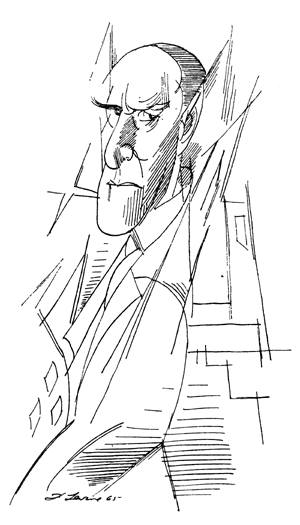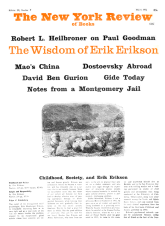The strength of the German artistic tradition has always been its graphic rigor. For pure painterly values, for pictorial conceptions that allow finer shades of feeling than the graphic alone can ever fully accommodate, German artists have had to look elsewhere—to Italy or Spain or France or, more recently, the United States. The work that has resulted from this confrontation of graphic genius with alien pictorial traditions has sometimes been magnificent, and not at all a mere rehearsal of received style; the oeuvres of Lovis Corinth, Paul Klee, and Max Beckmann, among others, are ample testimony to the fact. Yet the free play of painterly sensibility has never taken hold. Every generation of German artists has had to begin again from the beginning, suffering the frisson of the painterly tradition as a fresh shock and acquiring its resources only through painful personal growth.
This confrontation was particularly crucial for the artists who came of age in the decade preceding the First World War, the decade in which the School of Paris was at the height of its powers. In a purely formal sense, modern German art can be divided between those artists who found in Fauvism—and in the gods the Fauvists especially favored: Gauguin and Van Gogh—the necessary impetus to a style of their own, and those who, eschewing the emotional freedom of Fauvism, adopted Cubism as a more viable and universal grammar of form. The one resulted in Expressionism, which, for all its mysticism and otherworldly aspiration, was a style addressed to the things of this world. The other produced a kind of metaphysical Cubism which used the formal devices of this most Parisian style as a scaffolding for exploring an imaginative empyrean in which there was no clear demarcation between the world of spirit and the world of matter.
The principal exponent of this metaphysical Cubism was Paul Klee, whose observation, “In my work, man is not a species but a cosmic point,” can be taken as its motto. Lyonel Feininger’s remark (in a letter to Mark Tobey), that “What I want to do is capture some of the cosmic wonders,” places him unmistakably in this line. Yet Feininger’s gifts, like Klee’s, were formed in the German graphic mold, whose procedures and assumptions place it at a pole far removed from the Cartesian refinements of Cubist aesthetics. Feininger’s development from a talented cartoonist and illustrator into a painter fully cognizant of the most momentous revolutions in modern form thus constitutes for the critic a peculiarly interesting case of an artist who reformed his entire outlook on art while remaining completely loyal to his own sensibility. There are some dramatic turns in Feininger’s development, but none of those dispiriting tergiversations by means of which certain of his contemporaries felt at liberty to re-invent their personalities at the onset of every shift in aesthetic fashion.
Feininger has been fortunate in his expositors. A few years ago Dr. Hans Hess produced a lengthy and comprehensive monograph on the artist which is a model of its kind. Now Professor Scheyer has written a book far smaller in compass, more specialized, but nonetheless important. It concentrates on Feininger’s early life in America, his career as a successful cartoonist and illustrator in Germany, France, and the United States, and his transformation into a serious painter under the impact of the School of Paris. Its special value lies in the documents Professor Scheyer has assembled to illuminate these early, crucial chapters of Feininger’s long career—mainly the artist’s correspondence with two close friends, H. Francis Kortheuer and Alfred Vance Churchill, and reproductions of the comic strips, cartoons, and caricatures which provided him with his first livelihood and reputation. All in all, the book is a valuable pendant to Dr. Hess’s more exhaustive study, and in itself affords an intimate and delightful glimpse into the art history of the turn-of-the-century. (The material on the artist’s later years—Feininger died in 1956 at the age of eighty-five—is of more perfunctory interest.)
Feininger was born in New York in 1871, and, except for his periodic visits to Paris, lived in Germany from 1887 to 1937. He always retained his American citizenship, and it is now customary to include him in surveys of American art, but this is more an act of social courtesy, I think, than of considered aesthetic judgment. His work clearly belongs to modern German art in the development of which it played a distinct, if minor, role. Even his childhood and youth in America were overshadowed by the German outlook of his parents, who—like Klee’s—were musicians and wanted their son to follow a musical career.
Professor Scheyer lays great emphasis—rightly, I believe—on the abiding influence which Feininger’s early interests and environment exercised over his later development, particularly his romantic preoccupation with the wonders of technology and engineering, his musical education, and his lyrical feeling for nature. These interests, already highly developed during his American years and intensified in Germany, pre-disposed Feininger to adopt a view of the world, and of his own experience, that was more notable for its fantasy and innocence than for its firm grasp of the direction in which modern life was actually moving. One reason perhaps why Feininger was able to enter so freely and successfully into a career as a humorous illustrator, especially as an illustrator for children, was this predisposition toward innocent and high-minded ideals.
Advertisement
The other reason for his success was, of course, his remarkable gifts as a draftsman. Feininger began earning his living as a cartoonist for the Berlin papers at the age of nineteen, and his career in that field was an immediate and astonishing triumph. Between 1890 and 1906 he contributed an immense variety of cartoons, caricatures, illustrations, and comic strips to journals in Germany, France, and the United States, even working for a time as a liberal political cartoonist on Ulk, the Sunday supplement to the Berliner Tageblatt. Toward the end, in Paris, he worked for the journal Le Témoin at the same time as Juan Gris, and he brought his career to a close in 1906 with two comic strips, “The Kin-der-Kids” and “Wee Willie Winkie’s World,” which flourished briefly in the pages of the Chicago Tribune.
By that time, however, Feininger was determined to devote himself to serious art. His sojourn in Paris had brought him into contact with the modern movement for the first time. He discovered Cézanne, Van Gogh, and Matisse, and struck up a friendship with Pascin (who also earned his living as an illustrator). It was not until 1906, in fact, that Feininger—at the age of thirty-five—first painted in oils. He turned down an invitation to join the Tribune staff, a job that would have brought him back to the U. S., and instead dispatched his cartoon strips from Paris until he decided to abandon that lucrative career altogether.
It was Feininger’s encounter with Cubism in 1911 which decided the course his art would take thenceforth. But his was from the start a Cubism markedly different from the style practiced by his Parisian contemporaries. Feininger himself described it as “visionary” Cubism, and behind that precise designation lay not only his enthusiasm for Turner and Whistler—and thus for light as a primary subject—but also something of his graphic gifts as well. Feininger’s early critics spoke of the prismatic of “crystalline” quality of his pictures, and the characteristic works of his maturity were, in fact, a kind of Cubist transmutation of this romantic preoccupation with light and atmosphere. Never a strong colorist, Feininger was nonetheless able to bring his graphic powers to bear on the construction of monumental prisms of light—symbols, in his own imagination, of a simpler and more spiritual world than any to be seen with the naked eye.
These symbols all retained a recognizable relation to the observable world, however. Feininger was not, in the sense that other Cubists were, an abstract artist. Both landscape and urban motifs abounded in his work, and the artifacts of modern technology existed side by side with figments of the Biedermeier revival, but they all tended more and more to represent a pure country of the mind. In Feininger’s vision, the impedimenta of modern experience were exquisitely dissolved in an unearthly light and refracted into a form of visual pastoral that harked back to the innocent, mystical emotions of his youth. One of the virtues of Professor Scheyer’s study is the way it shows us this transition from the fantasies of the cartoonist to the visionary imagery of the painter. In the course of this transition, as often happens in German art, painting was not so much mastered or enlarged as simply enlisted as an instrument, but it yielded Feininger exactly what he needed to transcend the limits of his graphic talent and address his art to the “cosmic wonders.”
This Issue
May 6, 1965




